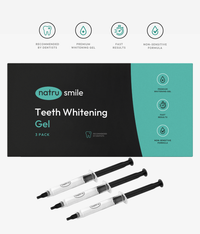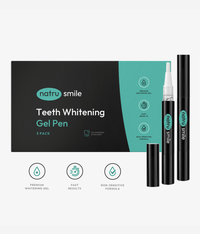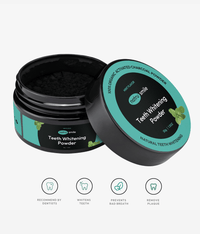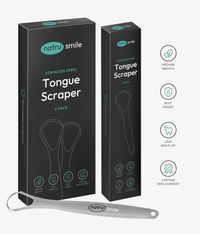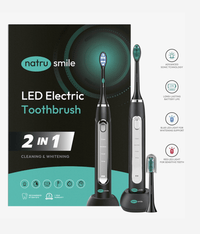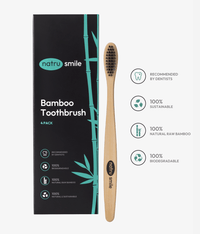
All products are certified by dental expert Dr. Greg Grillo
Temporary veneers are sort of like the band-aids of cosmetic dentistry. Just like how a band-aid can temporarily “fix” a wound, temporary veneers can be used to cover up any imperfections in your smile and provide you with an improved aesthetic look - but only for a short period of time.
Veneers are an increasingly popular option for people who want to make cosmetic improvements without undergoing more permanent treatments such as crowns or dental implants. And temporary veneers are either used before you get the real thing or as a less permanent option for those who want it.
Curious about the ins and outs of temporary veneers? We'll discuss what temporary veneers are, how they work, and what they’re for.
Temporary Veneers: Overview
Temporary dental veneers are custom-made thin shells that can be applied directly to the front surface of your teeth. They’re also known as trial veneers in some cases. Made from either composite resin (a type of plastic) or porcelain, they’re designed to match the shape, shade, and texture of your existing teeth.
The goal is for them to look natural on you, so people won't even realize that you're wearing them - they just think it's part of your real smile! Just when veneer technology came about, manufacturers produced them in a range of shapes, sizes, and colors. This allowed dentists to choose from the selection for their patients.
Now, we have the luxury of custom-made veneers specifically molded and shaped to your teeth. They’re now made from resin into pre-selected sizes and shapes and placed using a bonding process to your teeth.
People often choose veneers as a way to correct small aesthetic issues like chips, cracks, gaps, or discoloration. They can also be used to hide minor misalignments and overlaps in your teeth.
There are two different types of temporary dental veneers:
- Ones that look like permanent veneers but only last 7 to 10 days
- Custom-made removable snap-on veneers
However, for the purposes of this article, we’ll be focusing on option one. Note that there are also such things as gum veneers, which are temporary veneers that cover only the gum line to create a more symmetrical smile.
The Process Of Temporary Veneers
The process of getting temporary veneers is fairly straightforward. First, your dentist will take photographs of your existing teeth. Then, they’ll take an impression of your existing teeth so they can make a custom-fitted set of temporary veneers. This usually involves using a special putty or paste that is placed in the mouth and then removed to create the mold.
If you’ve already decided on permanent veneers, your dentist may perform the enamel removal process.
Once the mold has been created, it is sent off to a dental laboratory, where the actual veneer shells are made out of either composite resin or porcelain. When the veneers are ready, your dentist will bond them to the front surface of your existing teeth using a special adhesive. Finally, they'll be polished and shined up so that they look just like natural teeth!
Temporary Veneers Vs Permanent Veneers
Many people who are considering veneers will likely be wondering: What’s the difference between temporary and permanent veneers?
- Duration: The main difference between temporary and permanent veneers is the duration. Temporary veneers last anywhere from 7 to 10 days, while permanent veneers can last up to 20 years or more if properly cared for.
- Cost: Another factor that plays into your decision-making process is cost. Temporary veneers, as one might guess, tend to be significantly less expensive than their permanent counterparts.
- Results: The results of temporary dental veneers will be less dramatic than with permanent veneers. This is because they are made from a thinner material and only cover the visible part of your teeth, whereas permanent veneers can also be used to reshape or realign them.
- Material: Temporary veneers are made of either composite resin or porcelain; permanent veneers are usually made from porcelain. These differ in terms of durability and longevity, with porcelain being the more durable option.
- Less invasive: Unlike permanent veneers, temporary veneers are not cemented to the teeth. They can easily be removed and replaced with a new set when necessary. This means that they do not require any drilling or grinding of your tooth enamel like permanent veneers do - which is why they’re so popular!
What Problems Can Temporary Veneers Solve?
Temporary veneers can be used to fix a wide range of cosmetic issues. They are often chosen by people who want to try out the look and feel of permanent veneers before committing to them, as well as those who need an immediate fix for certain events such as weddings or job interviews.
Who Is An Ideal Candidate For Temporary Veneers?
Temporary veneers are a great option for anyone who is looking to eventually get permanent veneers to make small improvements to their smile. They’re often used as a trial period before investing in permanent veneers, which is beneficial because it allows you to get an idea of how the finished product will look on you and if it’s something you really like.
Since the process is totally reversible, you can get a feel for how the veneers will look on you before deciding to go through with it.
Here are the most common issues that temporary veneers can solve:
- Gaps between teeth
- Discoloration or staining
- Chipped, cracked, or misshapen teeth
- Minor misalignments
- Uneven gum line
- Unsightly metal fillings
Although it is a great solution for cosmetic issues, the patient must:
- Have healthy gums: This is important for the success of the procedure since veneers require a high level of oral hygiene.
- Have adequate enamel: Veneers depend on healthy tooth structure to stay in place, so if your enamel has been eroded due to brushing too hard or consuming acidic foods and drinks, it may not be a suitable option for you.
- Not grind their teeth: Grinding your teeth may weaken your enamel but also disqualify you for permanent veneers.
- Not have severe teeth fractures or severely misshapen teeth: In cases like these, it’s not recommended to get temporary veneers because they won’t be able to correct the problem. It would also be difficult for your dental professional to fit the veneers at all - so, in this case, you’ll want to consider crowns instead.
How Long Do Temporary Veneers Last?
Temporary dental veneers typically last anywhere from 7 to 10 days before they need to be replaced. This is because, over time, the material of the veneer will start to wear down and may no longer look natural on your teeth.
It's important to note that temporary veneers are not meant as a long-term solution for cosmetic issues - they are only meant as a short-term fix while you decide whether or not you want to commit to permanent treatment.
The Benefits Of Temporary Veneers
The main advantage of temporary veneers is that they allow you to get a preview of what your smile could look like after permanent treatment. This can be helpful if you’re considering having more permanent cosmetic dentistry done but aren't sure if it's right for you.
With temporary veneers, you can get an idea of how the new look will fit into your lifestyle and whether or not it would make you feel comfortable and confident.
Another benefit is that they're much less invasive than permanent veneers and can be done in a single visit. Plus, since temporary veneers are non-permanent, you don't have to worry about any of the risks associated with more significant dental work, such as gum recession or altered sensation in your teeth.
If you’re already prepared to get permanent veneers, your dentist may use these temporary veneers as a trial run. You can wear them and get real-world experiences with your new teeth and ensure you’re happy after choosing the right veneer color, shape, and size before the permanent ones are created.
As well, if you’ve gotten your teeth prepared for the veneers already before your next dental appointment, temporary veneers can offer a protective barrier against hot, cold, and hard foods.
The Cost Of Temporary Veneers
The cost of permanent veneers can go quite high, given that the treatment cost includes enamel removal, taking the impression, and custom-made veneers. As temporary veneers are a just-for-now fitting, they cost a lot less at $200 - $400 per arch (all the teeth in the bottom or lower jaw).
Some dental offices may offer payment plans which allow you to spread out the cost over a few months. Another way to finance your procedure would be to sign up for a discount dental plan. With this plan, you might be able to get some of the cost off. But, since this is a cosmetic procedure, it may not qualify.
If you still haven’t got your questions about temporary veneers answered, we’ve addressed some frequently asked questions below.
Can You Eat With Temporary Veneers?
Yes, you can eat with temporary veneers, but you should take some precautions to avoid damaging them. Temporary veneers are designed to protect your teeth while you wait for your permanent veneers to be made, and they are not as strong or durable as permanent veneers.
To ensure your temporary veneers stay in good condition, we recommend avoiding hard, crunchy, or sticky foods that could cause them to break or become dislodged. Here are some tips for eating with temporary veneers:
- Stick to soft foods: During the time you have temporary veneers, it's best to stick to soft foods that won't put too much pressure on your teeth. This includes things like soups, cooked vegetables, soft fruits, and eggs.
-
Avoid sticky or chewy foods: Foods like caramel, taffy, and gummy
candies can stick to your temporary veneers and pull them off your teeth. It's best to avoid these types of foods altogether. - Cut your food into small pieces: If you want to eat something harder or crunchier, like a raw carrot or apple, it's best to cut it into small pieces first. This will reduce the amount of pressure on your teeth and reduce the likelihood that your temporary veneers will become damaged.
- Chew on the other side of your mouth: If you do need to eat something harder or crunchier, try to chew it on the opposite side of your mouth from your temporary veneers. This will reduce the amount of pressure on the veneers and make it less likely that they will become damaged.
Overall, be careful and mindful of what you eat while you have temporary veneers. If you do accidentally damage your veneers, be sure to contact your dentist right away so they can make any necessary repairs.
What Are The Problems With Temporary Veneers?
While temporary dental veneers are intended to protect your teeth and provide a natural-looking appearance, there are a few potential problems you should be aware of.
They may not fit perfectly: Temporary veneers are typically made using a mold of your teeth, which means they may not fit as well as your permanent veneers will. Ill-fitting veneers may lead to discomfort, especially if they’re too tight or too loose.
They may be less durable: Temporary veneers are not as strong or durable as permanent veneers, which means they are more prone to chipping or breaking. This is why it's important to be careful with what you eat while you have temporary veneers.
They may not look as natural: While temporary veneers are designed to look as natural as possible, they may not look quite as good as your permanent veneers will. As mentioned, temporary veneers are often made using a composite resin, and they may not be able to match the exact shade or texture of your natural teeth.
Are Temporary Veneers Obvious?
Temporary veneers are designed to look and feel like real teeth. They will be matched to your existing teeth in order to make them look natural and blend in with the rest of your smile. Plus, they’ll be made from materials that mimic the look and feel of real tooth enamel.
That being said, temporary veneers can sometimes be obvious if people know what they're looking for - such as when a dentist is examining your mouth or if you open your mouth wide to smile. So, while they’re usually not obvious, be aware that there is a possibility that someone might notice them.
Can You Brush Your Teeth With Temporary Veneers?
Yes, you can brush your teeth with temporary veneers. But you’ll want to make sure that you are gentle when brushing and flossing - too much pressure can damage the veneer or even cause it to come off.
Do Temporary Veneers Smell?
Temporary dental veneers do not smell. They are made of materials that don’t produce any odor and won't affect the way your breath smells. That being said, if you have an underlying problem with bad breath or halitosis, then speak to a dentist before having temporary veneers applied - it could mean something more serious.
Do Veneers Weaken Teeth?
A common concern people have about veneers is that they might weaken teeth and make them prone to further damage. Fortunately, temporary veneers don't actually weaken your teeth at all. They are simply placed directly over the existing tooth surface and bond with it in order to give a more uniform appearance.
How Do You Clean Temporary Veneers?
Practicing good oral hygiene will maintain the appearance of your teeth and make sure the temporary dental veneers last for their intended duration. You should brush twice daily with a soft toothbrush and floss at least once daily.
When cleaning your teeth, avoid using abrasive toothpaste or hard bristles, as this could damage the temporary veneer.
Can You Go Back To Your Normal Teeth After Veneers?
Yes, you can go back to your normal teeth after temporary veneers. Temporary veneers are not permanent and do not require any alteration of the existing tooth structure. Once the temporary set is removed, your natural teeth will be completely intact and undamaged.
With permanent veneers, however, the tooth structure must be altered in order to make room for the new veneers. After they are removed, your natural teeth will remain permanently changed.
Are Temporary Veneers Bulky?
No, temporary veneers are not bulky. In fact, they can be made from a variety of materials that allow for a very thin and comfortable fit. This makes them much less noticeable than permanent veneers and more suitable for people who want to make subtle changes to their smile.
Can Temporary Veneers Be Whitened?
You cannot whiten composite veneers, as they are simply a thin layer of material placed on top of your existing teeth. When it comes to teeth whitening vs veneers, the whitening solution won’t be able to penetrate through the material like it would with natural teeth. If you find that the temporary set has become discolored over time, it's easy to replace them with a new set.
Are Temporary Veneers Painful?
Temporary veneers do not cause any pain. They provide a comfortable and secure fit that many people find quite pleasant. They won't affect your speech or eating habits either.
Are Temporary Veneers Uncomfortable?
Getting temporary dental veneers fitted is generally comfortable and should not cause any discomfort. The material they're made of is soft and malleable, so it won't irritate your gums or the inside of your mouth.
Are Temporary Veneers Necessary?
Although useful and beneficial, they aren’t a necessity for everyone. They can be a great option if you want to make quick cosmetic improvements to your smile without undergoing more permanent treatments. Temporary veneers can also be used as a trial run before committing to more permanent solutions such as crowns and implants.
Comparing dental crowns vs veneers, crowns are more suitable for restoring severely damaged teeth, while veneers are better suited for cosmetic purposes.
If you have missing teeth, there’s no competition between dental bonding vs veneers – dental bonding to replace them is the only option.
How Are Temporary Veneers Removed?
Temporary veneers are designed to be easily removed. Your dentist will use a special bonding agent to attach the temporary veneers to your existing teeth, and they can be simply peeled off when it is time for them to be removed.
Can Temporary Veneers Stain?
As they’re made of composite resin, they tend to stain more easily than permanent porcelain veneers. Between porcelain vs composite veneers, composite veneers are less expensive and more cost-effective. But, they require regular maintenance to ensure your desired look is maintained.
If you smoke or drink coffee or tea regularly, your temporary veneers may become discolored. Luckily, you can prevent this by avoiding these activities while wearing the temporary set and practicing good oral hygiene habits.
How Are Temporary Veneers Made?
Temporary dental veneers are typically made of a thin, clear plastic material that is molded and shaped to fit your teeth. The molding process is done with the help of dental impressions taken by your dentist. After the mold is created, it's then placed over your existing tooth and heated until it forms a tight seal around the tooth.
How Are Temporary Veneers Fitted?
The application process only takes a few simple steps. The veneers will be heated until they become malleable and fit tightly against your teeth. Then, your dentist will bond them to your existing tooth structure using a special adhesive.
Are Temporary Veneers One Piece?
No, they’re made of a thin layer of plastic material that is molded and shaped to fit each individual tooth. Each one of your teeth will have its own customized fitting veneer.


